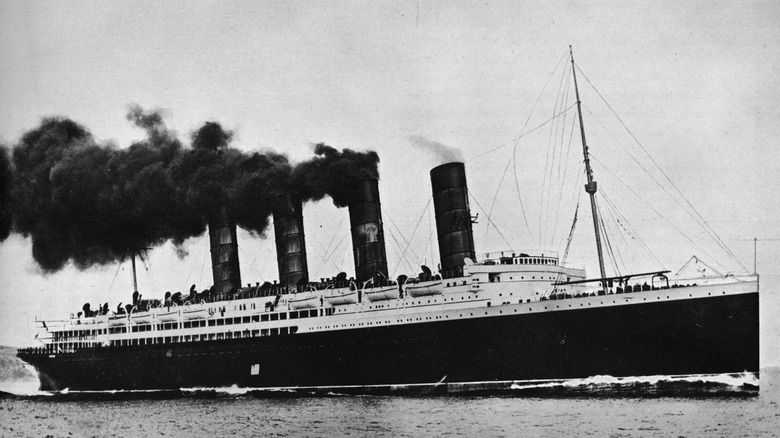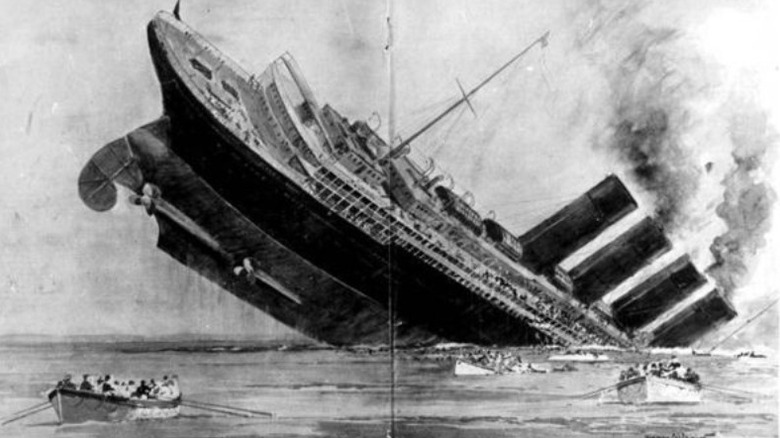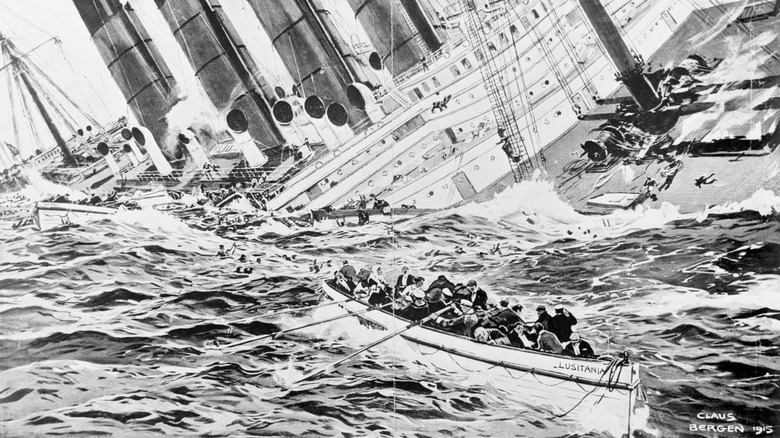The Reason Why The World-Renowned Lusitania Sank So Fast During World War 1
The Lusitania and the RMS Titanic are two of the most majestic vessels the British have ever produced. Both tragically sank, causing enormous loss of life. What's particularly notable about the two awful events, though, is how long the vessels took to sink after becoming stricken. For Titanic, it was a harrowing 160 minutes after the collision that the ship finally slipped away, which is a stark contrast with Lusitania, which sank in a mere 18 minutes. It disappeared so quickly, in part, because of the unique circumstances of the disaster.
RMS Lusitania, infamously, was intentionally sunk by hostile action. U-20, one of the dreaded German U-boats, struck it with a torpedo in May of 1915, unknowingly becoming one of the most historically significant military subs of all time in the process. This great blast, naturally, was a primary factor in the disaster. The National Archives quotes Walther Schwieger, commander of the U-20, as later writing, "Clear bow shot at 700 [meters] . . . Shot struck starboard side close behind the bridge. An extraordinarily heavy detonation followed ... A second explosion must have followed that of the torpedo (boiler or coal or powder?)." Schwieger went on to note that, following this second blast, the ship roiled and "quickly listed sharply to starboard, sinking deeper by the head at the same time."
The initial torpedo strike struck a structural vulnerable point on the ship, and Merseyside Maritime Museum curator Ian Murphy is quoted by the Express as noting that a strike at such a point could be enough in and of itself to sink the ship. However, it also appeared to have the secondary effect of causing another blast, as Schwieger noted, which potentially increased the damage sustained by the ship and so left it more vulnerable.
The mysterious explosion after the torpedo strike
That second explosion after the torpedo strike remains the subject of theorizing and debate over a century after the event. Multiple blasts rocked the Lusitania, and it's possible that what exploded after the torpedo hit the hull was a stockpile of British munitions. In 2014, The Guardian quoted newly-released British government files from 1982 that revealed the extent of what the Lusitania was carrying. The Foreign Office's Noel Marshall reportedly wrote in 1982 that though "Successive British governments have always maintained that there were no munitions on board ... The facts are that there is a large amount of ammunition in the wreck, some of which is highly dangerous." Britannica reports that a great deal of rifles and their ammunition were aboard, approximately 173 tons' worth. As for what these other hazardous weapons may have been, it remains unclear, but there were volatile elements aboard the ship that could have contributed to its swift loss.
In the chaos that naturally ensued in the wake of the torpedo strike, there are conflicting accounts regarding the cause of the second explosion, and whether the second explosion was a follow-up torpedo impacting the ship. The New York Times' historic front page proclaimed that the Lusitania had been "twice torpedoed off the Irish coast", but any further impacts after the first remain unconfirmed. The second explosion, then, may not have been another attack, or a spontaneous detonation of the munitions the vessel was reportedly carrying. Instead, it's likely that it was caused by a reaction from powder or coal dust in the wake of the initial impact, owing to the area of the ship that the initial projectile struck. Few u-boats remain today, but their devastating impact on history certainly does.
Why the Lusitania was targeted
The Lusitania's fateful final trip took place during a time when British vessels were considered legitimate targets whether they were a military threat or not. For an island nation, of course, such an approach had the potential to be devastating, and it was instigated early in 1915 in response to British actions the previous year, which saw widespread port blockades with the intent of denying opposing nations deliveries of supplies. The oceans of the world, needless to say, were a dangerous place to be, and measures such as these and widespread minelaying would also have meant trouble for those who weren't even involved in the war. The reality of great inconvenience at best and potential peril at worst meant that nobody was safe, such was the fraught international situation.
The Lusitania was not a military vessel, and so its targeting and swift sinking naturally caused horror. Famously, the attack could have been one of the most significant events of the war, as the deaths of 128 Americans who had been aboard was a contributing factor in the United States joining the Allies' cause in April 1917. It was far from the only one, though, as Germany had targeted other non-military vessels in the months following the sinking of Lusitania and would ultimately target U.S. civilian ships too. This was believed to be the key to defeating the British quickly, and the thinking among the German leadership was that the aggressive strategy was worth committing to. As the Japanese would discover in the wake of the attack on Pearl Harbor decades later, though, the mighty U.S. war machine is not to be taken lightly, and the Lusitania's sinking would be a big factor in the Allied powers' ultimate victory.


